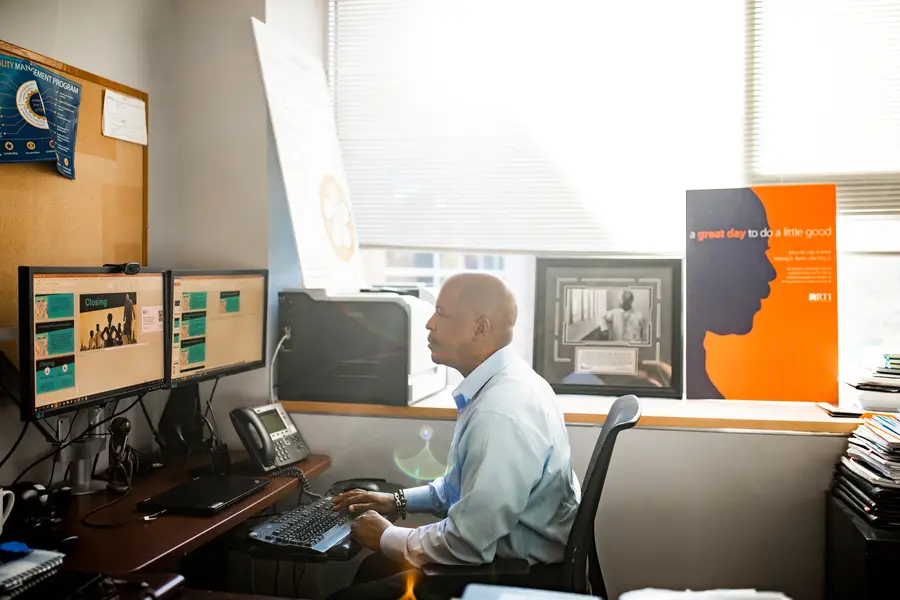Communities in Context
Phillip Graham studies individual motivations and cultural factors that affect adolescent risk behaviors.
Phillip Graham studies individual motivations and cultural factors that affect adolescent risk behaviors.

Phillip Graham is passionate about context. And community.
A very broad description of his work would be this: research focused on preventing the negative consequences of adolescent risk behaviors, including violence and substance use.
But Graham dives deeper into his work, down to the ground-level to capture the critical cultural and community context to consider when studying high-stakes problems like opioid abuse and community violence. He focuses on using science to engage communities in better problem solving, how to use data to inform not only what interventions are selected but how they are applied and implemented in communities.
He and his colleagues analyze the context of the work—the underlying factors that are most associated with the desired outcome of the project—stripped of preconceived notions and definitions that could potentially lead the team astray.
For example, Graham’s team once evaluated an intervention for rural, two-parent African-American households. Through the evaluative process, the team learned that the same intervention might not be right for the same behavior for urban, single-parent African-American households, he noted.
Or, an intervention in Minnesota that included using snowmobiles for transportation would not be appropriate for Louisiana.
In essence, researchers should consider cultural context when designing interventions or attempting to apply them in new settings and focus on community-based participatory research.
“Many of the interventions that government tries to replicate are often demonstrations of community successes, but what they fail to often realize is that those community successes came with lots of failures along the way,” Graham notes.
“You can’t replicate a model without understanding how they got to that success.”
Taking the time to understand what motivates individuals and individuals within specific communities is key to Graham’s philosophy.
“It is that understanding that we are trying to incorporate into rigorous applied research and evaluation—to understand how interventions operate in a real-world setting,” he adds. “We can transform communities with data-driven processes to inform what interventions should be selected and implemented. We bring that lens of context to make sure we are not missing key things that may or may not lead to addressing an outcome.”
At RTI, Graham leads three fields: (1) Substance Use Prevention, Evaluation and Research, which strives to prevent and reduce substance use, related risk behaviors, and their consequences; (2) Mental Health, Risk and Resilience Research, which works on promoting mental well-being and preventing violence among both general and vulnerable populations; and (3)Community Health and Implementation Research, which conducts epidemiological studies on social and structural factors that impact health risk and infectious disease, along with implementation science research to make interventions and other solutions more effective.
One of Graham’s current projects is an evaluation of an initiative to address trauma and healing among boys and young men in specific communities.
“It really challenges the notions of how we bring Western approaches to the evaluation of indigenous practices, how we understand the relevance of indigenous practices and how they may be valued. Sweat lodges are a practice believed by Native Americans to help with healing from trauma. If you understand some of the key elements and tenets of sweat lodges, you will conclude they are like what Westerners call mindfulness. When we put a label on it from a Western perspective, it becomes acceptable; in an indigenous environment, it is not so easy.”

Graham is also a proponent of weaving “citizen scientists” into the process of performing research within the context of the community.
“If you really want to develop interventions that significantly impact the lives of the community, why not have community involved in development of theory? Citizen scientists have an important role in the interpretation of our findings,” Graham adds.
“You can run the best statistical models, but if you don’t understand the context or look at those numbers in isolation, you might misinterpret the results.”
Context is playing an important role in Graham’s analysis of interventions to combat opioid misuse. While there has been a lot of attention paid to the role of opioids in pain management leading to misuse and addiction, the same factors that have always driven people to misuse alcohol, cocaine, or heroin are relevant in understanding the pathways to dependence and addiction, he points out.
Not enough research has delved deeper than the pain management and overprescribing factors—to surface to consider the underlying community causes like poverty, unemployment and mental health disorders that make people vulnerable to various types of substance abuse.
Only by unearthing the unique community characteristics that drive a particular behavior can adequate interventions be devised, Graham adds. Furthermore, understanding the social networks that exist within the community can allow researchers to suggest solutions that lead to opportunities or resources for those who need them.